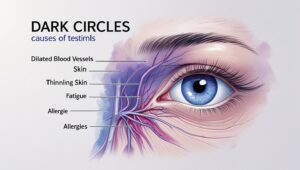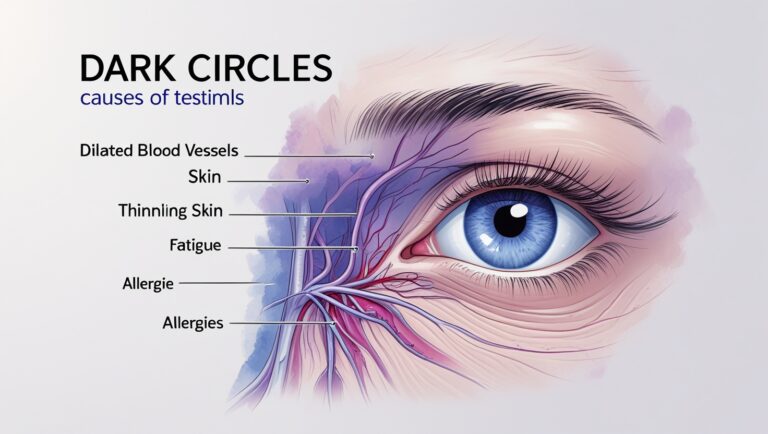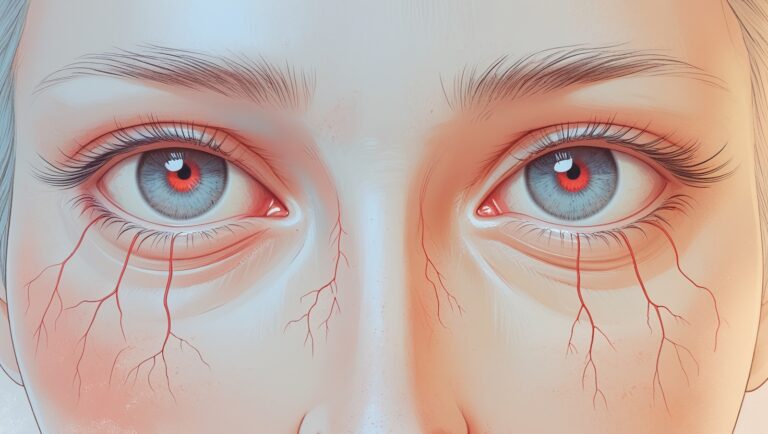Table of Contents
- Introduction
- What Happens to Your Eyes During Screen Time?
- Understanding Digital Eye Strain (Computer Vision Syndrome)
- Key Symptoms of Prolonged Screen Exposure
- Common Myths vs. Facts About Screen Use and Eye Health
- Long-Term Effects of Excessive Screen Time
- How Much Screen Time Is Too Much?
- Real-Life Scenarios of Screen-Induced Eye Problems
- Science Behind Screen-Related Eye Fatigue
- Tips to Protect Your Eyes During Screen Use
- Lifestyle Habits to Support Eye Health
- When to See an Eye Doctor
- Eye Care in the Digital Age: What’s New in 2025?
- Conclusion and Call to Action
1. Introduction
In a world where smartphones, laptops, tablets, and televisions dominate our daily lives, it’s natural to ask: Can prolonged screen time damage my eyes? Whether you work from home, binge-watch Netflix, or scroll through social media for hours, your eyes are working overtime.
This guide will walk you through how screen exposure affects your vision, signs that indicate you may be overdoing it, and simple ways to protect your eyes in today’s digital age.
2. What Happens to Your Eyes During Screen Time?
When you stare at a screen, your eyes are constantly focusing, shifting, and adjusting. This demands more effort than reading a book or looking at something far away.
Effects include:
- Less frequent blinking (leading to dry eyes)
- Increased exposure to blue light
- Eye muscle fatigue
Over time, these small issues can add up and cause noticeable discomfort.
3. Understanding Digital Eye Strain (Computer Vision Syndrome)
Digital Eye Strain, also called Computer Vision Syndrome, refers to a group of eye and vision-related problems caused by prolonged screen use.
Key contributing factors:
- Poor lighting
- Glare on the screen
- Improper viewing distances
- Poor posture
- Uncorrected vision problems
4. Key Symptoms of Prolonged Screen Exposure
You might be dealing with screen-related eye issues if you experience:
- Blurred vision
- Eye fatigue or soreness
- Dry or watery eyes
- Headaches
- Neck and shoulder pain
- Difficulty focusing after screen use
5. Common Myths vs. Facts About Screen Use and Eye Health
Myth: Looking at screens will permanently damage your eyes.
Fact: While screens don’t cause permanent blindness, prolonged use can lead to chronic discomfort and vision issues over time.
Myth: Blue light is the most dangerous form of light.
Fact: Blue light can interfere with sleep cycles and may contribute to eye strain, but natural sunlight emits far more blue light than screens.
Myth: Kids are safe because their eyes are younger.
Fact: Children’s eyes are still developing and may be even more sensitive to long hours of screen time.
6. Long-Term Effects of Excessive Screen Time
Although there’s no evidence that screens cause permanent eye damage, overuse may contribute to:
- Chronic dry eye syndrome
- Myopia (nearsightedness), especially in children
- Disrupted sleep patterns
- Decreased visual efficiency
Did You Know? By 2025, experts estimate that over 50% of the global population will be nearsighted—partly due to screen habits and indoor lifestyles.
7. How Much Screen Time Is Too Much?
While no universal rule applies, many experts recommend:
- Adults: Limit non-work screen time to under 2 hours per day
- Children (ages 2–18): No more than 1–2 hours of recreational screen use daily
- Infants (under 2): Avoid screen exposure entirely
Breaks, proper setup, and healthy habits matter more than strict limits.
8. Real-Life Scenarios of Screen-Induced Eye Problems
Scenario 1: A software engineer reports blurred vision and headaches after coding for 10 hours straight.
- Likely cause: Uninterrupted screen time without breaks
Scenario 2: A teenager develops dry eyes and difficulty focusing during online classes.
- Likely cause: Excessive screen exposure without blinking or hydration
Scenario 3: A graphic designer complains of neck pain and double vision.
- Likely cause: Poor ergonomic setup and uncorrected vision
9. Science Behind Screen-Related Eye Fatigue
When we focus on a digital screen:
- Blink rates drop by over 50%
- Eye muscles remain contracted
- Blue light suppresses melatonin (affecting sleep)
These changes increase stress on your visual system. Over time, your eyes become less efficient and more sensitive to fatigue.
10. Tips to Protect Your Eyes During Screen Use
The 20-20-20 Rule
Every 20 minutes, look at something 20 feet away for 20 seconds. This reduces eye muscle fatigue.
Proper Lighting
Avoid screen glare by using soft lighting. Position your monitor to reduce direct reflections.
Screen Settings
- Increase text size for easier reading
- Adjust brightness and contrast to comfortable levels
- Use “dark mode” when possible
Blue Light Filters
Use blue light glasses or enable built-in blue light filters on devices, especially in the evening.
11. Lifestyle Habits to Support Eye Health
- Eat foods rich in omega-3s, vitamin A, and lutein (e.g., salmon, carrots, spinach)
- Stay hydrated to maintain tear production
- Get regular eye exams (at least once a year)
- Spend time outdoors in natural light
- Reduce screen use before bedtime
12. When to See an Eye Doctor
You should consult an optometrist or ophthalmologist if you experience:
- Persistent blurry vision
- Constant headaches or migraines
- Eye pain or pressure
- Trouble focusing at any distance
- Vision changes after extended screen use
13. Eye Care in the Digital Age: What’s New in 2025?
With digital device use higher than ever in 2025, eye care technology is adapting:
- Smart contact lenses that monitor eye hydration
- AI-powered apps for tracking screen time and visual fatigue
- Wearable screens with built-in blue light regulation
These tools help users manage screen time more effectively and protect their long-term vision.
14. Conclusion and Call to Action
Yes, prolonged screen time can strain your eyes—but it doesn’t have to damage them.
By taking small, consistent steps—like using the 20-20-20 rule, adjusting your workspace, and eating a vision-friendly diet—you can support your eye health and work comfortably in the digital world.
Take Action Today:
- Adjust your screen settings for comfort
- Start using breaks strategically
- Schedule your next eye exam
- Share this article with a friend or coworker who spends long hours in front of a screen
Your eyes work hard every day. Give them the care and rest they deserve.
Visit for more :- Greakstive
External References & Further Reading:
- Effects of Excessive Screen Time on Your Eyes
- Screen Time & Your Eyes: What the Research Says
- Digital Devices and Your Eyes









